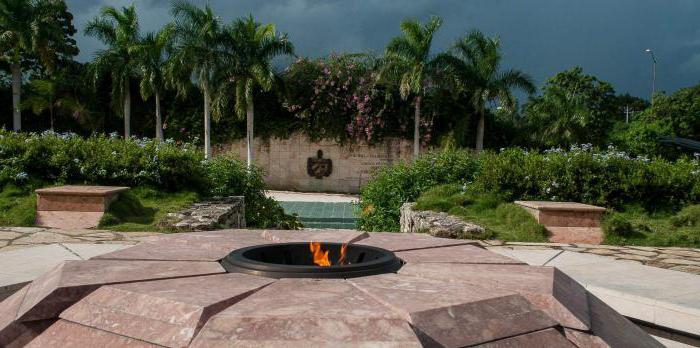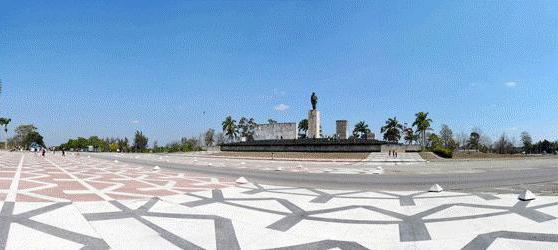Holidays in Cuba have long surprised no one. And if you do not want to just lie on the beach and listen to the ocean surf, but decide to learn a little about this country, visit the Che Guevara Mausoleum. This tomb of the cult hero of not only the Cuban revolution, but also all the youth of the world with leftist aspirations (or simply informally oriented) is among the ten tombs of the world worth visiting by tourists. Today we will talk about who Che Guevara was, why he earned such fame and what can be seen in Santa Clara, where this mausoleum is located.
Description
First, let's see what this tomb looks like. It is a large memorial complex, which is located on the Revolution Square in the Cuban town of Santa Clara. Why exactly here? Because it is believed that at this place a famous world revolutionary won one of his most significant victories. And when this event turned thirty years old, in 1988, this complex was opened here. At first, he was not a tomb at all, but only a memorial place. In its very center stands a huge monument to the revolutionary (22 meters high), surrounded by four steles on which his winged sayings are knocked out and scenes from the battle for Santa Clara are depicted. Right at the foot of this giant sculpture is a museum. There you can see things that belonged to the cult hero, as well as learn about the history of his life. The mausoleum of Che Guevara is also located under the monument and contains the remains of not only the famous revolutionary, but also his twenty-nine comrades who died with him.
How the complex was built
Construction was decided to start at this place because it offers a beautiful view of Santa Clara. And the battle near this city, historians believe, was the last in the epic of the revolution in Cuba, which led to the coming to power of Fidel Castro. The city itself is located almost three hundred kilometers from Havana. The architects Jorge Campos and Bao Linares, as well as the sculptor Jose Dellara, participated in its creation. The mausoleum of Che Guevara was built by several hundred thousand volunteers, although experienced professionals also took part in the construction of the facility.
The symbolic meaning of the memorial
If you describe this complex in a few words, then we can say that it looks like a large square with a monument in the center. Directly opposite the sculpture are shields where Fidel’s sayings are written in huge letters, as well as Che’s famous motto “Always to victory!” The mausoleum of Che Guevara is primarily symbolic. The revolutionary himself is depicted dressed in an old leather jacket and with a gun. He seemed to be turned in the direction of Bolivia, pointing to the place where he was dealt with. Quotes on stelae and images on bas-reliefs underline the constant striving of this amazing person for revolutions. On some, he is carved in stone together with Fidel and other leaders of the Cuban uprising, when they prepared it in the mountains of Sierra Maestra. On others, as minister of the first revolutionary government. And on some steles, a farewell letter to Fidel Castro is reproduced.
Additional sculptural groups
Near the main facilities of the complex are others. The mausoleum of Che Guevara (Cuba) is dedicated not only to memory, but also to the description of the life of a famous revolutionary. Therefore, there is a special sculptural group depicting the battle of Santa Clara. Indeed, in fact, the dictatorship of the former ruler of Cuba - Batista - was overthrown precisely thanks to the efforts of Che. When an armored train with soldiers and weapons that were going to defend the government approached Santa Clara, the revolutionary took several tractors with the assistance of students from the agricultural department of the local university and used them to raise the rails. The armored train was not able to go further, and the military who were there began to ask for a truce. A day later, Fulherio Batista fled from the island. This episode is reflected in the bas-reliefs of the mausoleum. By the way, the wreckage of this armored train is still located in the city of Santa Clara, and you can look at them as a historical landmark.

Museum
What else is interesting in such a structure as the mausoleum of Che Guevara? A photo of the complex shows us that a statue of a romantic revolutionary can be seen from anywhere. That is why it is located on the outskirts, and not in the city center. And the museum, which is located under the sculpture, contains extremely interesting exhibits. Here are hundreds of rarest photographs in which this person appears before us very multifaceted, diverse and unexpected. We see him eating a hamburger or playing golf. And in some pictures he looks just like a real gangster. It also houses his beret, which has gained worldwide fame, as well as a medical diploma and an asthma inhaler.
Becoming
But why did Ernesto Che Guevara become a symbol of any revolutionary upheaval, the struggle against lies and injustice? Why did the omnivorous mass culture adopt his rebellious image, and T-shirts and caps with his image can be bought on any market in any country? Why is the mausoleum of Che Guevara in Santa Clara so attractive to tourists from all over the world? Probably, the whole point is the character, determination and radicalism of this heroic revolutionary. His life goal, he did not consider coming to power, but a constant struggle for those who were destitute, impoverished and powerless. He was born in Argentina, traveled a lot in his youth, learned to be a doctor. When he traveled to different countries of Latin America, he was outraged that the elite lived on money, and ordinary people did not have the opportunity to eat three times a day. This was facilitated by US policy. Indeed, in Latin America there were many different corporations that collaborated with dictators and corrupt officials there.

Revolution in cuba
In Mexico, Ernesto Che Guevara met Castro, whom he pushed to prepare for an uprising. And when he and a small group of people on a small boat called Granma landed in Cuba, only part of the conspirators broke into the Sierra Maestra mountains. No wonder the mausoleum of Che Guevara (Cuba) has steles and bas-reliefs dedicated to this event. After all, it was with the help of the Argentinean romance that this handful of revolutionaries was able to overthrow the power of a man who relied on a thirty thousand army. Che Guevara created his own army, where Cuban volunteers came, which is why he was nicknamed the “Commander”. And when Fidel came to power, Ernesto, having worked a little as a minister, decided that this was not his activity, and went on to make a world revolution.
The death of the Comandante
A turbulent fate brought Che Guevara to Bolivia, whose authorities, frightened by the scale of his activities, called for the help of the American allies and organized real persecution. Special services of almost all neighboring countries tracked down the revolutionary and comrades from his detachment. Ernesto himself constantly suffered from asthma attacks that worsened in the Bolivian jungle, but despite this, as the evidence provided by the museum and the mausoleum of Che Guevara (Santa Clara) shows us, he provided medical assistance to both his comrades-in-arms and prisoners. In 1967, the location of the detachment was discovered, it was defeated, and the commandant himself was captured. In the end, the Bolivian soldiers received an order to execute him, and they even drew lots about who would carry him out. Interestingly, the then military dictator of Bolivia assured to the end of his life that he did not give such an order. As evidence of the murder of a revolutionary, the executioners amputated the hands of a corpse.
Burial place
Bolivian general Mario Vargas Salinas, witness of the capture and execution of Ernesto, after several decades of silence, in 1997, revealed the secret burial place of Che Guevara and his comrades. They were buried under the runway of the airfield in Vallegrande. Then the Cuban government turned to the Bolivian with a request to begin excavations at this site. And indeed, after a year and a half of searching, corpses of people were found there. One of them had no hands. It was these bodies that Che Guevara's mausoleum (Santa Clara, Cuba) took to the burial site. They were buried there with all due military honors. This celebrity was attended by many celebrities, such as the widow of French President Mitterrand and soccer player Diego Maradona. The mausoleum itself, where the dead were buried, was built in the form of a partisan dugout, it is small and dark. The remains of the heroes are walled up in its walls, between which there is a path like a forest, and at its end an eternal flame burns. Quiet music of guitar strings is played there all the time.

Mausoleum of Che Guevara: reviews
Most tourists who visit this place leave feedback full of exaltation and delight. They write that this is really a cult, iconic complex. Only here, according to them, you can really understand who this great man really was, to feel his extraordinary power and charisma. After all, Che Guevara is in many ways a mysterious person, and at this point he seems to be revealed to you. In the museum, contemplating his personal belongings, letters, weapons, as if immersed in that era. On the other hand, all these are objects that are not related to the revolution - they simply show Che as an ordinary person, such as you and I. It is respected, no matter what your political views. The museum is very cool, comfortable and clean. By the way, photography and video shooting are prohibited inside the mausoleum, so all visitors are checked before entering. The complex is located in the west of the city, and everyone here will tell you where the mausoleum of Che Guevara is located, how to get to it. From the center of Santa Clara, it’s best to walk along Marta Abrue Street and in ten minutes you will be there. You need to go by car along the same route.